Blogs
Sara Defratyka – AirCore: simple tool better than magical tricks
Blog written by Sara Defratyka
There is a moment in each PhD’s life when students have to bring to life what they read in articles and confront expectation with reality. This moment can be a perfect occasion to test new ideas to improve daily work. For me, this opportunity came when I was on secondment in the Royal Holloway University of London and I tested a tool called AirCore. AirCore is a long decarbonized tube, which allows to store air. Thank to this, air can be measured twice: in monitoring and in ‘replay’ mode. In practice, AirCore can be used to ‘replay’ a sequence where a peak of methane has concentration higher than 0.5 ppm (particle per million) above background concentration. When observed concentration returns to the background level, we change mode for replay one and the instrument reanalyses the air stored in the tube. As in replay mode, the flow is about three times slower than in monitoring mode, we can record more measurement points than in monitoring mode.
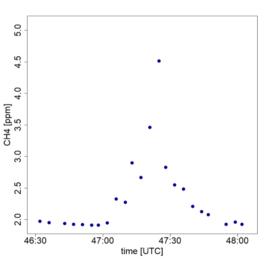 |
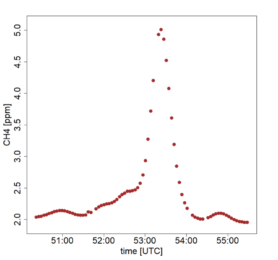 |
|
Peak observed in monitoring mode |
Peak observed in replay mode |
This simple tool allows to obtain better time resolution and accuracy for 13CH4and measure isotopic composition after observation of CH4peak directly at the survey time.
During my secondment, five mobile surveys were conducted and in four of them, AirCore was used. After campaigns, isotopic compositions ‘replayed’ with Aircore were compared with results obtained off-line from a mass spectrometer in RHUL. The results obtained are quite similar and show that Aircore is a promising tool. In the future, I plan to improve AirCore work and make about three measurements with AirCore from one site and calculate the isotopic signature of a particular CH4source as average from this measurement.
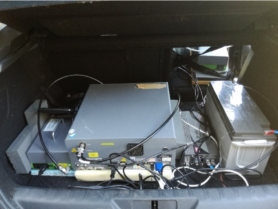 |
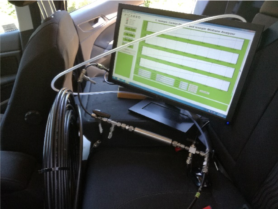 |
|
CRDS analyser during mobile measurement |
50 m of decarbonized tube and switch as AirCore |
During my time in RHUL, not only did we run mobile campaigns but we also compared results obtained during stationary measurement by my CRDS laser analyser side by side with RHUL’s IRMS mass spectrometer, both from air bags and from the continuous measurement of outside air from one common inlet. Air in bags had a different isotopic composition and different concentration of CH4. The continuous measurements were conducted during three nights. In both cases, results are compatible within uncertainty.
 |
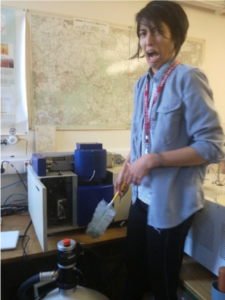 |
 |
|
Lab work: CRDS analyser, |
small cleaning, |
IRMS during air bags measurement |
Secondment in the Royal Holloway University of London was the perfect occasion to test this new tool and to conduct campaigns in a different area than Ile de France, on which I concentrate during my PhD. It was also an opportunity to compare results from different instruments. Thanks to this I can be sure that results from my analyser are correct and they will be useful in the future.
 |
 |
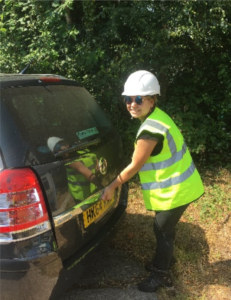 |
|
Field work: CRDS results and Stonehenge in the background, |
preparation to survey, |
work on Heathfield landfill |
However, PhD life is not only work and measurement, so secondment in a different country is the perfect occasion to experience culture, masterpieces and cuisine. It would be a pity to be in England and don’t visit the British Museum or the Natural History Museum. Probably riding a bike on the left side of the route close to well-known double deck red buses will be one of the most unforgettable experiences in my life. Even if during PhD, there is a lot of tasks and scientific challenges, there should be always time to meet with other people and to discover delightful places, for example like a beach on the North Sea, where you can feel like during holidays on the Mediterranean Sea.
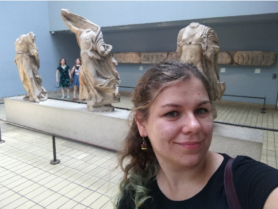 |
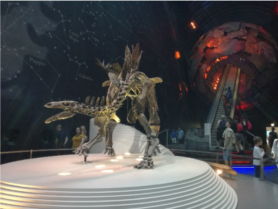 |
||
|
British museum |
Natural History Museum |
||
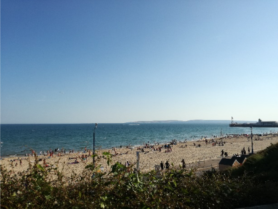 |
 |
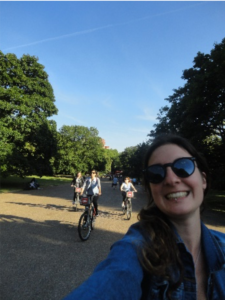 |
|
|
North Sea and sky without clouds |
Spare time 😉 |
||

